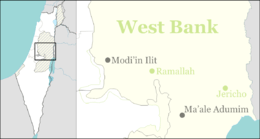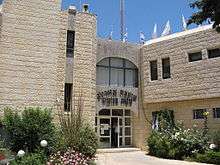Psagot
| Psagot | |
|---|---|
|
| |
 Psagot | |
| Coordinates: 31°53′57.48″N 35°13′26.04″E / 31.8993000°N 35.2239000°ECoordinates: 31°53′57.48″N 35°13′26.04″E / 31.8993000°N 35.2239000°E | |
| District | Judea and Samaria Area |
| Council | Mateh Binyamin |
| Region | West Bank |
| Affiliation | Amana |
| Founded | 1981 |
| Founded by | Beit VeGan residents |
| Population (2017)[1] | 1,848 |
Psagot (Hebrew: פְּסָגוֹת, lit. Peaks) is an Israeli settlement in the West Bank located north of Jerusalem on Tawil hill adjacent to Ramallah, al-Bireh, and Kokhav Ya'akov. Established in 1981, it is organised as a community settlement and falls under the jurisdiction of Binyamin Regional Council, with the council's headquarters located there.[2] In 2017 it had a population of 1,848.
The international community considers Israeli settlements in the West Bank illegal under international law, but the Israeli government disputes this.[3]
Etymology
The name Psagot was proposed by one of the early residents, Moshe Bar-Asher, a professor and head of the Academy of the Hebrew Language. It expresses the hope that the new village will achieve a peak in settlement and study of the Torah.[4] The name also refers to the location of Psagot on the peak of Mount Tawil.[2]
History
The Arabic name of the hill is Jabel Tawil (long mountain).[5]

Before 1967, Jabel Tawil was known to locals as "Kuwaiti hill" because of numerous visitors from the Persian Gulf who hiked in the area.[6][4] In 1964, some of the land was purchased by the Jerusalem municipality for a future tourist resort.[6] In the Six-Day War, it came under Israeli control. From September 1976, Arabs were prohibited from building in the area.[7]
In 1981, Ariel Sharon, then Israeli Minister of Defense, told Pinchas Wallerstein, head of the Mateh Binyamin Regional Council, that he would support initiatives to settle the area.[4] In July 1981, Wallerstein moved the council headquarters to the hill, then occupied by a military intelligence base. Five families from the Jerusalem neighborhood of Beit VeGan took up residence there. A year later, they were joined by a group from the Kerem B'Yavneh yeshiva who came to create a kollel.[6][4]
Israeli–Palestinian conflict
According to B'Tselem, Psagot prevents the expansion of Ramallah and cuts it off from the surrounding villages.[8] During the course of the Second Intifada, snipers shot at Psagot from buildings in Ramallah, leading to the construction of a concrete wall to protect the inhabitants. In 2001, the Israeli army stationed nearby fired two missiles into Ramallah targeting Marwan Barghouti.[9]
In November 2009, the Psagot settlement and Regavim petitioned the High Court of Justice in an unsuccessful attempt to stop construction of the Al-Bireh International Stadium, citing security concerns.[10]
The Sasson Report identified Psagot as the "parent settlement" of an Israeli outpost known as Mitzpe HaAi (Hebrew: מִצְפֵּה הָעָי) located approximately 400 m to the southeast.[11] According to the report, the settlement, unauthorized by the government, was built on land appropriated illegally from its Palestinian owners. According to Peace Now 75.69% of the combined area of Psagot and Mitzpe HaAi is on appropriated private land.[12]
Status under international law
The international community considers Israeli settlements to violate the Fourth Geneva Convention's prohibition on the transfer of an occupying power's civilian population into occupied territory.[13]
Israel disputes the applicability of the Fourth Geneva Convention and argues that the Palestinian territories were not legally held by a sovereign when Israel took control of them. This view has been rejected by the International Court of Justice and the International Committee of the Red Cross.[14]
Economy
The Psagot Winery was founded by Na’ama and Yaakov Berg, who planted vineyards in 1998.[15] In addition to a modern barrel cellar, some of the oak barriques are stored in a cave dating back to the Second Temple era. The winery’s top wine is a Bordeaux blend named Edom. Regular varietal wines are produced in the Psagot series and there is also a Port-style wine. In 2007 and 2008, the winery produced 65,000 bottles annually.[16] In 2010, the winery produced 80,000 bottles of wine a year, the majority for export. By 2015, the number produced had grown to 250,000 bottles per year, of which 65% are exported.[17] Palestinian Arabs and Israeli Jews work there side by side, creating an island of co-existence in sea of mistrust.[18] The American evangelical Christian organization HaYovel has sent volunteers to tend and harvest Psagot Winery's vineyards.[19] Berg says calls to boycott his wines have only increased demand.[15] The winery has developed into "a favourite destination" for right-wing Israeli and American politicians.[17] Other wineries exist around Psagot, and the Yesha Council hopes to make them a tourist attraction. According to the local Palestinians and the Israeli human rights group Yesh Din, the wineries are partially planted on privately owned Palestinian land.[20][21]
References
- ↑ "List of localities, in Alphabetical order" (PDF). Israel Central Bureau of Statistics. Retrieved August 26, 2018.
- 1 2 HaReuveni, Immanuel (1999). Lexicon of the Land of Israel. Miskal – Yedioth Ahronoth Books. p. 795. ISBN 965-448-413-7.
- ↑ "The Geneva Convention". BBC News. 10 December 2009. Retrieved 27 November 2010.
- 1 2 3 4 Hoberman, Haggai (2008). Keneged Kol HaSikuim [Against All Odds] (in Hebrew) (1st ed.). Sifriat Netzarim. pp. 196–7.
- ↑ E. H. Palmer (1881). The Survey of Western Palestine. Arabic and English name lists. London: The Committee of the Palestine Exploration Fund. p. 296.
- 1 2 3 Hilal, Sandi; Alessandro Petti; Eyal Weizman (Spring 2009). "The Future Archaeology of Israel's Colonisation". Afterall Journal (20).
- ↑ Arab Women's Information Committee; Lebanese Association for Information on Palestine (1977-01-01). The Arabs Under Israeli Occupation, 1980. Inst for Palestine Studies. p. 67.
- ↑ Brightonpalestinecampaign.org
- ↑ Whitaker, Brian (3 September 2001). "The summit of Middle East tension". Guardian. Retrieved 28 October 2010.
- ↑ Hass, Amira (27 November 2009). "Settlers petition to tear down nearby Palestinian stadium". Ha'aretz. Retrieved 31 October 2010.
- ↑ Opinion on Unauthorized Settlements, Prime Minister's Office, 2005, Appendix I, "Detailed list of settlements", p. 37
- ↑ Psagot and Mitzpe Ha'ai (outpost) Archived 25 July 2009 at the Wayback Machine. Peace Now.
- ↑ The settlers' struggle BBC News. 19 December 2003
- ↑ Legal Consequences of the Construction of a Wall in the Occupied Palestinian Territory Archived 6 July 2010 at the Wayback Machine. International Court of Justice, 9 July 2004. pp. 44-45
- 1 2 Where you stand changes the view, Haaretz
- ↑ Psagot Winery at Rogov's Reviews
- 1 2 "Europe steps up pressure on Israel over its settlements". The Economist. 12 November 2015. Retrieved 15 November 2015.
- ↑ Peace with a paycheck, YNET, by Akiva Novick, 08.25.10
- ↑ Jeffay, Nathan (25 March 2012). "Christians Called To Serve Jewish Settlers". The Forward. Retrieved 7 April 2012.
- ↑ Settler vineyards take root in West Bank BBC. 17 June 2009
- ↑ Wallis Simons, Jake. "Meet the Settlers". Telegraph.co.uk. Retrieved 2018-05-22.
The Psagot Boutique Winery, which was established in 2003 just outside the Palestinian capital of Ramallah, is one of the largest, producing 200,000 bottles per year and covering 62 acres. According to the Israeli human rights group Yesh Din, it partially lies on private Palestinian land.